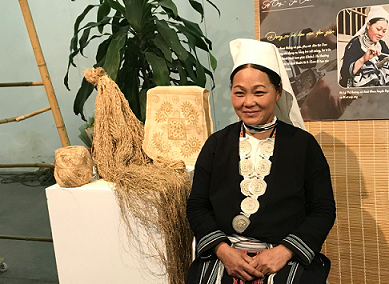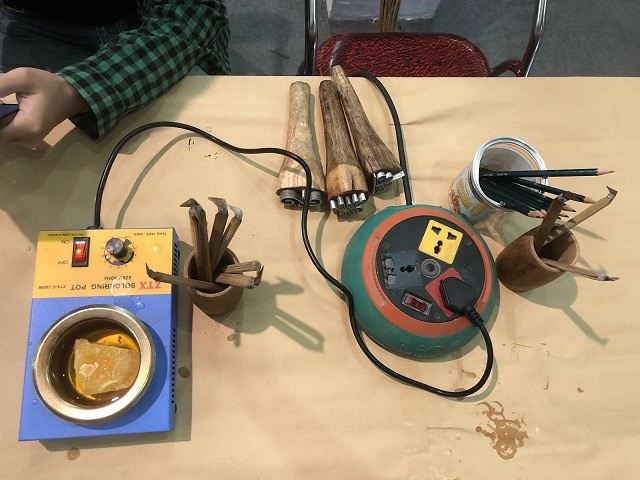
The beauty in the art of drawing beeswax on fabric
Latest
The surprising thing is that with simple tools such as bamboo and forest trees, these artisans have created impressive and eye-catching artistic products.
 |
| Dao Tien ethnic artisan Ly Thi Huong. (Photo: Phuong Thao) |
A meticulous and delicate process
For the Mong ethnic people (Mong Du, Mong Xanh), before drawing patterns with beeswax, the surface of the fabric (usually linen) must be flattened and the traditional flattening method called fabric rolling is extremely unique.
They place the cloth on a round piece of wood and use a large rock to place it on the cloth, then stomp on both sides until the cloth surface is flat. The person doing this step must be very skillful to maintain balance. At first glance, they look like circus performers.
The most meticulous step is beeswax drawing. The Mong people use a kind of special pen to draw which has pen handles made of bamboo, and pen nibs made from diagonal trapezoidal gold copper pieces with a small space in the middle to hold the beeswax.
When drawing, the pen is dipped in melted beeswax and placed in a position parallel to the fabric surface, gradually tilted along the drawing stroke until the beeswax is completely absorbed into the fabric. The thinner the nib, the more beautiful and easier the pattern is to draw.
In addition to the above traditional drawing method, currently the Mong ethnic women in Mai Chau, Hoa Binh have combined aluminum molds with pre-engraved patterns to make the drawing process faster and more convenient.
Particularly for the Mong Du and Mong Xanh ethnic groups, popular patterns are mouse paws and squares along the piece of fabric and a variety of other motifs.
According to Dao Tien ethnic artisans in Cao Bang, beeswax is taken from two bee caves that have existed for a long time and have been protected by people in the area until now.
When choosing a suitable day between June and July of the lunar calendar to hold the beeswax collection festival, the Dao Tien men go to the cave to collect wax, then people in the village contribute rice, chicken, incense and invite the shaman to come. After performing the ritual and worshiping, the villagers collect the beeswax together. The beeswax is then continuously cooked until it becomes beeswax lumps used for drawing.
Artisan Ban Thi Lien shared that the beeswax lumps are shared with the whole village. In years when a lot of beeswax is collected, each family gets 2kg of wax, and in years when it is little, each one gets 1kg, which is only enough to draw patterns on dresses for the Dao Tien women.
The drawing tools of the Dao Tien ethnic group are made of thinly whittled bamboo, bent into a triangle shape (called Goèe) with different sizes depending on the patterns.
In addition, Dao Tien women also use flattened “chít” leaves to draw - a type of leaf that the Cao Bang people often use to wrap cakes made of glutinous rice and bamboo tubes of different sizes.
In particular, the patterns on the skirts of Dao Tien women in Cao Bang province are also different from those in other provinces. The characteristic is similar to the name of the ethnic group, which is the shape of a coin expressing the desire for a prosperous life. Besides, mountainous shape symbolizing the mountainous region as well as the pace of life of the Dao Tien people - relying on nature to create products to serve life.
 |
| The Mong people‘s beeswax drawing tools. (Photo: Le Nhan) |
fter finishing drawing the patterns, the fabric is dyed with indigo and dipped in boiling water to remove the beeswax, then the patterns are revealed with a characteristic rustic color. The steps are very complicated, take a lot of effort and take more than a month to complete.
Preserving and promoting national cultural values
The technique of drawing beeswax on fabric is one of the unique cultural values of the Mong and Dao Tien ethnic groups, deeply ingrained in both their material and spiritual life.
Therefore, the Mong and Dao Tien women are always very conscious of preserving and promoting those values. All family members have beeswax painted costumes. From young to old, from mother to child, then to grandchildren and great-grandchildren, everyone knows how to draw beeswax on fabrics, Ms. Lien shared.
Painting beeswax on fabric is not simply a technique for drawing patterns on casual clothes but has now been introduced as a type of tourism experience for domestic and foreign tourists in local tourist villages. At the same time, Ministry of Culture, Sports and Tourism has supported funding to open classes to teach beeswax drawing on fabric for younger generations, in order to preserve this traditional technique.
Recently, in the cozy space at the event “Sáp ong - Sắc chàm” (means "Beeswax - Indigo" in English) at the Vietnamese Women's Museum, many young people enjoyed the experience of drawing patterns with beeswax on linen, and wore the Dao Tien and Mong ethnic groups’ traditional costumes.
Participating in drawing beeswax on fabric, Tran Thu Ha excitedly shared: "I feel that the patterns on the costumes are very beautiful, diverse and have many different meanings. Previously, I learned about these symbols, but did not have the opportunity to experience them directly. I feel that the event is really good and meaningful, somehow it helps me spread the culture of ethnic people to young people in Hanoi."
After trying on the Dao Tien women’s traditional costumes, another young guest, Ngoc Cham said: "I have never experienced wearing the costume like this so it’s really new to me!".
Unable to hide their excitement, the beeswax artisans at the event expressed their joy at having the opportunity to promote the traditional beauty of their ethnic groups to people in Ha Noi Capital and help strengthen solidarity between ethnic groups in Vietnam.
Dao Tien ethnic artisan Ly Thi Huong shared: "I hope more people know the beauty of our traditional costumes and visit Hoai Khao, Nguyen Binh, Cao Bang to understand more about this culture."
As for artisan Ban Thi Lien: "I am very happy to be able to bring the cultural characteristics of the Dao Tien ethnic group to people in the capital. I hope to spread the beauty of our costumes to every region of the country.”

















